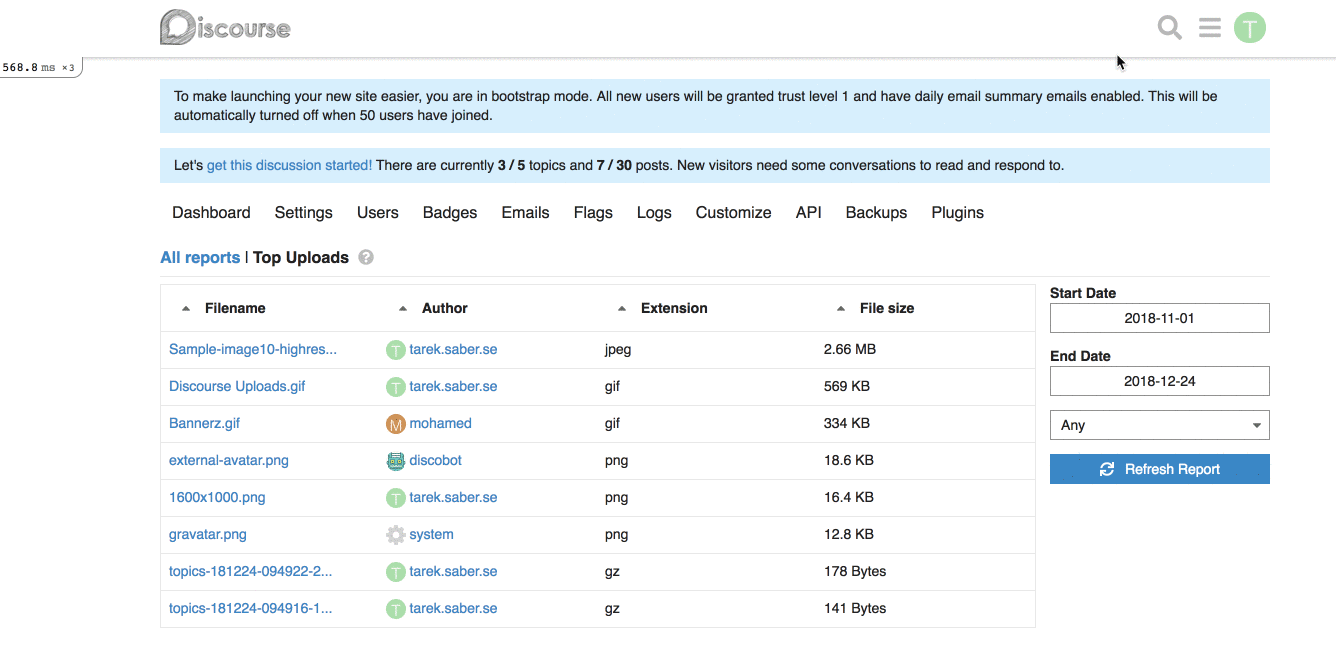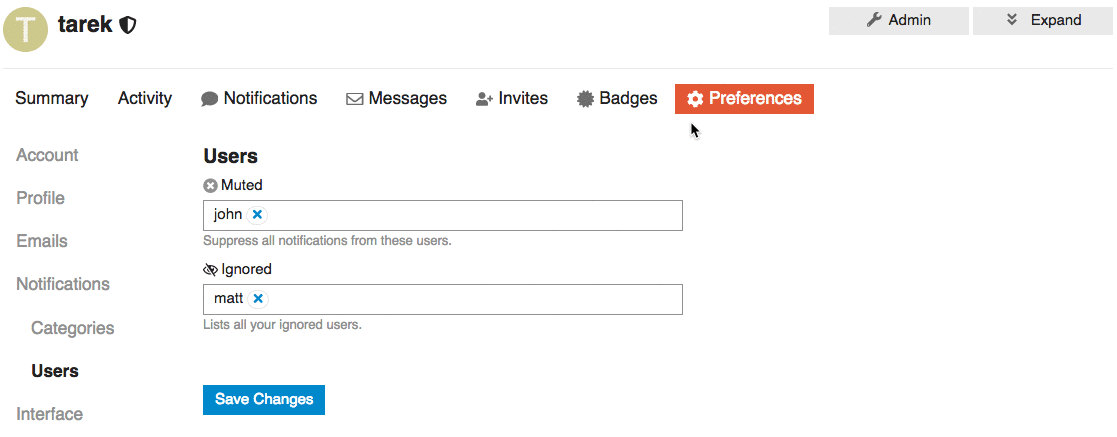This allows you to temporarily disable components without having to remove them from a theme.
This feature is very handy when doing quick fix engineering.
Adds a second factor landing page that centralizes a user's second factor configuration.
This contains both TOTP and Backup, and also allows multiple TOTP tokens to be registered and organized by a name. Access to this page is authenticated via password, and cached for 30 minutes via a secure session.
* SECURITY: Add confirmation screen when logging in via email link
* SECURITY: Add confirmation screen when logging in via user-api OTP
* FIX: Correct translation key in session controller specs
* FIX: Use .email-login class for page
We now show if a queued or flagged post is a reply to another when in
the review queue. It's especially helpful for queued posts where
normally they are linked to the topic where they are created, and you
have no context about the reply.
Note that this will only apply to new queued posts going forward.
Previously queued posts will not show the "in reply to"
This feature allows end users to "defer" topics by marking them unread
The functionality is default disabled. This also introduces the new site
setting default_other_enable_defer: to enable this by default on new user
accounts.
The problem here is that hour and minute were passed to the %{duration} variable which made them impossible to translate in other languages.
I wonder if it's worth having 2 almost identical translations just for "reached" and "exceeded"? Perhaps we could combine them in one copy?
* FEATURE: detect theme errors and catch them
* Bump COMPILER_VERSION
* Feedback
* Override eslint no console for one line
* Can't use our ajax method
* remove emoji from translation file
This is a feature that used to be present in discourse-assign but is
much easier to implement in core. It also allows a topic to be assigned
without it claiming for review and vice versa and allows it to work with
category group reviewers.
We found score hard to understand. It is still there behind the scenes
for sorting purposes, but it is no longer shown.
You can now filter by minimum priority (low, med, high) instead of
score.
This change automatically resizes icons for various purposes. Admins can now upload `logo` and `logo_small`, and everything else will be auto-generated. Specific icons can still be uploaded separately if required.
## Core
- Adds an SiteIconManager module which manages automatic resizing and fallback
- Icons are looked up in the OptimizedImage table at runtime, and then cached in Redis. If the resized version is missing for some reason, then most icons will fall back to the original files. Some icons (e.g. PWA Manifest) will return `nil` (because an incorrectly sized icon is worse than a missing icon).
- `SiteSetting.site_large_icon_url` will return the optimized version, including any fallback. `SiteSetting.large_icon` continues to return the upload object. This means that (almost) no changes are required in core/plugins to support this new system.
- Icons are resized whenever a relevant site setting is changed, and during post-deploy migrations
## Wizard
- Allows `requiresRefresh` wizard steps to reload data via AJAX instead of a full page reload
- Add placeholders to the **icons** step of the wizard, which automatically update from the "Square Logo"
- Various copy updates to support the changes
- Remove the "upload-time" resizing for `large_icon`. This is no longer required.
## Site Settings UX
- Move logo/icon settings under a new "Branding" tab
- Various copy changes to support the changes
- Adds placeholder support to the `image-uploader` component
- Automatically reloads site settings after saving. This allows setting placeholders to change based on changes to other settings
- Upload site settings will be assigned a placeholder if SiteIconManager `responds_to?` an icon of the same name
## Dashboard Warnings
- Remove PWA icon and PWA title warnings. Both are now handled automatically.
## Bonus
- Updated the sketch logos to use @awesomerobot's new high-res designs
Theme developers can include any number of scss files within the /scss/ directory of a theme. These can then be imported from the main common/desktop/mobile scss.
- Plugin developers using OpenID2.0 should migrate to OAuth2 or OIDC. OpenID2.0 APIs will be removed in v2.4.0
- For sites requiring Yahoo login, it can be implemented using the OpenID Connect plugin: https://meta.discourse.org/t/103632
For more information, see https://meta.discourse.org/t/113249
A new checkbox has been added to the Tags tab of the category settings modal
which is used when some tags and/or tag groups are restricted to the category,
and all other unrestricted tags should also be allowed.
Default is the same as the previous behaviour: only allow the specified set of
tags and tag groups in the category.
Includes support for flags, reviewable users and queued posts, with REST API
backwards compatibility.
Co-Authored-By: romanrizzi <romanalejandro@gmail.com>
Co-Authored-By: jjaffeux <j.jaffeux@gmail.com>
This reverts commit d1c4981f65.
Per discussion with @coding-horror it was decided this change is to
far reaching.
Instead we will make smaller strategic changes to tooltips that add
value.
* improved emoji support
- always optimize images as part of the task
- use the unicode standard ordering/naming for sections
* UX: more height for when there are recently used
Migrates email user options to a new data structure, where `email_always`, `email_direct` and `email_private_messages` are replace by
* `email_messages_level`, with options: `always`, `only_when_away` and `never` (defaults to `always`)
* `email_level`, with options: `always`, `only_when_away` and `never` (defaults to `only_when_away`)
* FEATURE: Exposing a way to add a generic report filter
## Why do we need this change?
Part of the work discussed [here](https://meta.discourse.org/t/gain-understanding-of-file-uploads-usage/104994), and implemented a first spike [here](https://github.com/discourse/discourse/pull/6809), I am trying to expose a single generic filter selector per report.
## How does this work?
We basically expose a simple, single generic filter that is computed and displayed based on backend values passed into the report.
This would be a simple contract between the frontend and the backend.
**Backend changes:** we simply need to return a list of dropdown / select options, and enable the report's newly introduced `custom_filtering` property.
For example, for our [Top Uploads](https://github.com/discourse/discourse/pull/6809/files#diff-3f97cbb8726f3310e0b0c386dbe89e22R1423) report, it can look like this on the backend:
```ruby
report.custom_filtering = true
report.custom_filter_options = [{ id: "any", name: "Any" }, { id: "jpg", name: "JPEG" } ]
```
In our javascript report HTTP call, it will look like:
```js
{
"custom_filtering": true,
"custom_filter_options": [
{
"id": "any",
"name": "Any"
},
{
"id": "jpg",
"name": "JPG"
}
]
}
```
**Frontend changes:** We introduced a generic `filter` param and a `combo-box` which hooks up into the existing framework for fetching a report.
This works alright, with the limitation of being a single custom filter per report. If we wanted to add, for an instance a `filesize filter`, this will not work for us. _I went through with this approach because it is hard to predict and build abstractions for requirements or problems we don't have yet, or might not have._
## How does it look like?

## More on the bigger picture
The major concern here I have is the solution I introduced might serve the `think small` version of the reporting work, but I don't think it serves the `think big`, I will try to shed some light into why.
Within the current design, It is hard to maintain QueryParams for dynamically generated params (based on the idea of introducing more than one custom filter per report).
To allow ourselves to have more than one generic filter, we will need to:
a. Use the Route's model to retrieve the report's payload (we are now dependent on changes of the QueryParams via computed properties)
b. After retrieving the payload, we can use the `setupController` to define our dynamic QueryParams based on the custom filters definitions we received from the backend
c. Load a custom filter specific Ember component based on the definitions we received from the backend
* FEATURE: Add ignored user list to the User's preference page
## Why?
Part of: https://meta.discourse.org/t/ability-to-ignore-a-user/110254
We want to add list of Ignored users under or along with the muted users preferences section.
This way Users can find and update their list of ignored users.
## UI

## Open questions
Two of many options to represent a list of ignored users is that we can:
1. We can represent the ignored user list as a table with the ability to `un-ignore` but NOT to add new ignored users.
2. We can keep it functioning as the `muted user list` where you can `un-ignore` or `ignore` users.
* Adds warnings to the "Edit Category" dialog
* Doesn't hide the "Security" tab on the "Edit Category" dialog anymore. Instead, it shows an explanation why permissions can't be changed.
* Makes the category name translatable
* Hides the category name from the edit dialog (it can be customized by overriding the translation)
* Creates a translation override if the category has been renamed in the past
Sadly there is no clean way of detecting a keyboard is connected to an iPad
If the keyboard is connected we want to disable all the touch related hacks
on iOS
This allows iPad users to specify they have a keyboard connected. Setting
is per device.
This commit also:
- removes [+ New Topic] behaviour from share, this feature has been duplicated in composer actions, months ago
- introduces our new experimental spacing standard for css: eg: `s(2)`
- introduces a new panel UI for modals
- These advanced fields are hidden behind an 'advanced' button, so will not affect normal use
- The editor has been refactored into a component, and styling cleaned up so menu items do not overlap on small screens
- Styling has been added to indicate which fields are in use for a theme
- Icons have been added to identify which fields have errors
New `about.json` fields (all optional):
- `authors`: An arbitrary string describing the theme authors
- `theme_version`: An arbitrary string describing the theme version
- `minimum_discourse_version`: Theme will be auto-disabled for lower versions. Must be a valid version descriptor.
- `maximum_discourse_version`: Theme will be auto-disabled for lower versions. Must be a valid version descriptor.
A localized description for a theme can be provided in the language files under the `theme_metadata.description` key
The admin UI has been re-arranged to display this new information, and give more prominence to the remote theme options.